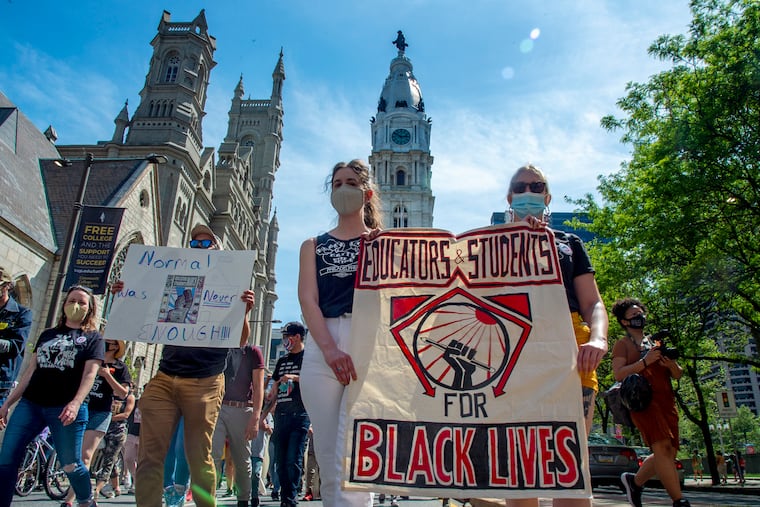Philly kids, teachers march for schools, racial justice: ‘Normal was never enough’
More than 100 students, teachers, parents and community members marched from City Hall to school district headquarters to demand better for kids going forward, including more school funding.

Christina Ly was a sophomore in high school when a ceiling in her school collapsed, raining pieces of plaster and streams of water into hallways at the Academy at Palumbo in South Philadelphia.
Palumbo educators had warned officials of problems at the school, but their warnings went unheeded. In addition to environmental problems, Palumbo, like all 220 schools in the Philadelphia School District, doesn’t have enough staff, enough supplies, enough money, Ly said.
She and a crowd of 100-plus students, teachers, parents and community members marched from City Hall on Sunday to school district headquarters to demand better for kids — more school funding, more mental-health supports, environmentally safe buildings, a more culturally responsive curriculum, and equal access to magnet schools and high-level courses for all students.
“We have poor schools in this poor city,” said Ly, now a senior at Palumbo, who, like most district students, will not set foot inside a classroom this year because of COVID-19. “Just because of where our Black, our Latinx, and our Asian students live shouldn’t be limiting their opportunity to pursue their future potential. This is bluntly unjust.”
Waving signs, chanting “when Philly schools are under attack, what do we do? Stand up, fight back!” and marching in time to a drum line, the crowd moved north, united in their demands.
Central High School senior Sheyla Street, a member of the Philadelphia Black Students Association and organizer of the march, underscored the need for antiracist curriculums “so that white kids don’t live their lives learning lies, so that Black kids live their lives with pride.”
Admissions policies at Philadelphia’s selective middle and high schools and access to Advanced Placement and other elite courses must be revamped, said Aniyah Harris and Shamiyah Boozer, seniors at George Washington Carver High School of Engineering and Science. District data show that Black and Latino students are underrepresented at high schools such as Carver, a magnet in North Philadelphia. (Carver student demographics roughly mirror the district’s however; at that school, 92% of students are of color; district-wide, it’s 85%.)
“And once you get into these schools, you have to fight to be treated the same as the other students,” said Boozer. “You have to fight against the clear-as-day racism.”
Boozer said that attendance should be eliminated or deemphasized as a criterion for selective admissions high schools. Her middle school attendance was poor, Boozer said, because she was responsible for getting younger siblings ready in the morning.
“No one would know why a student’s attendance is poor. No one ever asked,” Boozer said.
“We’ve got what it takes,” said Harris. “So just let us in.”
Beyond opening top-tier classes and schools to more kids of color, the district needs to take a hard look at its teaching force, which is mostly white, those who marched Sunday said.
“The data shows who’s really teaching us, and who’s in front of us,” Harris said. “The School District of Philadelphia needs to have a more focused initiative to recruit teachers who look like us.”
Many students struggled with issues of isolation and hopelessness, said Savannah Chapman, a sixth grader at Lingelbach Elementary in Germantown. Staff do their best, but are stretched too thin, she said.
“When we are experiencing the lows of anxiety and depression, we don’t have adequate access to the counselors or other mental-health professionals that we need to heal,” said Chapman.
Classmate Nolan Major, another Lingelbach sixth grader, said many district educators struggle to relate to their students — the majority of whom are poor and Black.
“They cannot relate to being surrounded by poverty and violence as they walk through their neighborhood,” said Major. “We need educators to reflect on their own racial identities, recognize implicit bias, and challenge systemic inequality in order to better serve us.”
Jordan Henry, another Lingelbach sixth grader, took the microphone outside school district headquarters to echo the rally’s theme.
“Normal,” Henry said, “was never enough.”
Standing on roller skates she strapped on to glide up North Broad Street, Keziah Ridgeway, a social studies teacher at Northeast High School, called for the district to begin an indigenous studies curriculum for students in grades K-12. She reminded the crowd that they were standing on land that was stolen from indigenous people.
“We have a duty to free the minds of our children,” Ridgeway said.
Dana Carter, a teacher and member of the Melanated Educators Collective, said the work of agitating until the school system does better would continue for as long as it needs to.
“We will not allow them to go back into the same old schools in September,” Carter said.